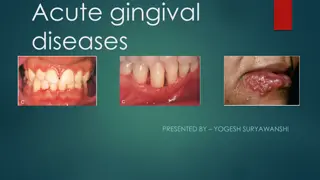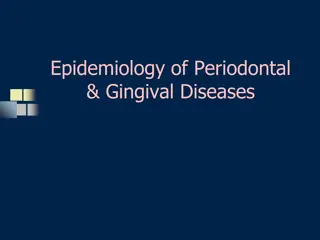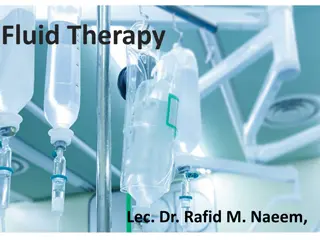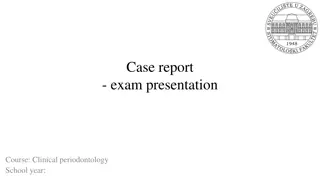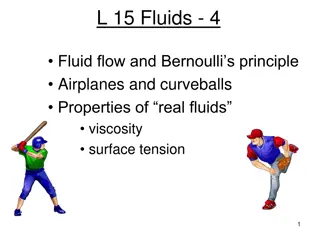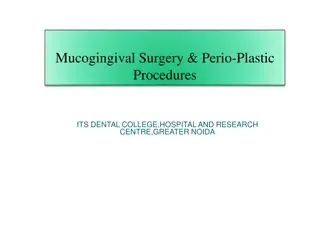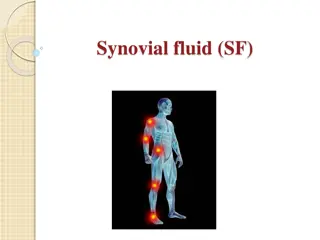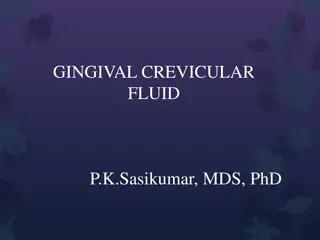Understanding the Defense Mechanism of Gingiva and Collection of Gingival Crevicular Fluid
Explore the intricate defense mechanisms of the gingiva against bacterial aggression and mechanical trauma. Learn about the collection methods and analysis of gingival crevicular fluid for understanding periodontal health. Discover the composition, role, and permeability of compounds in the gingival sulcular fluid. Evaluate the minimal amounts of GCF and methods for quantitative assessment, shedding light on periodontal disease research.
- Gingiva Defense Mechanism
- Gingival Crevicular Fluid
- Periodontal Health
- Composition and Collection
- Periodontal Disease
Download Presentation

Please find below an Image/Link to download the presentation.
The content on the website is provided AS IS for your information and personal use only. It may not be sold, licensed, or shared on other websites without obtaining consent from the author. Download presentation by click this link. If you encounter any issues during the download, it is possible that the publisher has removed the file from their server.
E N D
Presentation Transcript
Learning Objectives Gingival crevicular fluid saliva Quantity ,Methods of collection Function
Gingival Tissue Constantly subjected to mechanical trauma and bacterial aggression Saliva, Epithelial surface and inflammatory response provide resistance to these actions
Gingival Sulcular fluid Inflammatory ExudateHas been known since 19th century Composition and role in periodontal disease has been elucidated by pioneering work of Brill andKrasse in 1950. Filter paper in the sulcus of animals previously injected im with flourescein; within 3 minutes the flourescent from the filter paper
Method of collection of GCF Absorbing paper strips Twisted threads Micropipettes Intracrevicular Washings
Compounds found permeable to junctional and sulcular epithelium [Brill and krasse (flourecein dye)] Albumin Endotoxin Thymidine Histamine Phenytoin Horse radish Peroxidase Substances with mol wt upto 1000KD were permeable
The amount of GCF on paper strip can be evaluated The wetted area on paper strip can be visualized by staining with Ninhydrin and measures plainimettrically or on enlarged photograph with glass or a microscope Electronically through blotter paper (Periopaper) using electronic transducer (Periotron, Harco Electronics, Winnipeg, Manitoba, Canada) The wetness of paper affects the flow of electronic current and gives digital readout
Amount of GCF is extremely small 1.5 mm wide filter paper inserted 1mm into the pocket only absorbs 0.1mg of GCF in 3 minutes Mean GCF volume in proximal surface of molar teeth ranged from 0.43-1.56 l in human volunteer with mean gingival index less than 1
Composition More than 40 compounds from GCF have been analysed but their origin is not known with certainity They can be derived from host, bacteria like Collagenases (MMPs), B-glucouronidases
Cellular element: Bacteria,Desquamated epithelial cells and leukocytes(PMN's, Lymphocytes, Monocytes/macrophages) Electrolyt :, K , Na and Ca have been studied in GCFPositive correlation of Ca and Na conc and Na/K ratio with inflammation
Organic Compounds Organic compounds: Glucose hexosamine and hexuronic acid are two compounds found in GCF Blood glucose is 3-4 times greater thanserum Total protein content is much less thanserum
Metabolic products in GCF Metabolic products in GCF lactic acid, urea, hydroxyproline,endotoxin cytotoxic substances,Hydrogen sulphide and antibacterial factors
Methods to analyze GCF composition Methods to analyse GCF composition Fluorometry: MetalloproteinasesELISA:Enzymes and IL-1 Radioimmunoassay:Cyclooxygenase derv. and Procollagen III HPLC:Timidazole Direct & Indirect Immunodot test: Acute phase proteins
Cellular and Humoral activity in GCF IL-1a and IL-1 increase the binding of PMNs and monocyte/macrophage to endothelial cells and stimulate the production of PGE-2 and release of lysosomal enzymes and stimulate bone resorption
Clinical significance GCF is inflammatory exudate and positively correlates with amount and severity of inflammation GCF flow is increased by Mastication, coarse food, toothbrushing, gingival massage, Ovulation, Hormonal contraceptives and smoking
GCF secretion follows cicardian periodicity increases 6am to 10 pm then decreases afterwards Female sex hormone increase GCF flow as they enhance vascular permeability
Mechanical stimulation like chewing and vigorous tooth brushing increases GCF flow Smoking causes immediate transient but markedincrease in GCF flow There is increase in GCF production during healingperoid following periodontal surgery
Drugs in GCF Tetracycline and Metronidazole are secreted through GCF
Leukocytes in dentogingival area PMNs are the most common leukocytes present in the Gingival sulcus Neutrophils are the first line of defense in the Dentogingival area. Gingival sulcus is the port of entry of leukocytes into the oral cavity
Leukocytes are present in gingival sulcus even when histologic area are free of inflammatory infiltrate Differential count of leukocytes from clinically healthy human gingival sulci have shown 91.2% to 91.5% PMNs and 8.50 8.8% mononuclear cells
Mononuclear cells have 58% B cells, 24% T cells and 18% mononuclear phagocytes The ratio of T-lymphocytes to B- lymphocytes is reversed from from normal 3:1 in peripheral blood to 1:3 in GCF
Saliva It's a physiologic secretion by various major and minor salivary glands Its has got certain major functions like mechanical cleansing, lubricating and buffering actions It has got antibacterial property as well
Antibacterial factors Can be divided into Inorganic factor 2. Organic factor
Inorganic factors Includes ions and gases like Bicarbonate, Na, k, Phosphate, Ca,Ammonium, and Carbon dioxide
Organic factors ; includes Enzymes like Lysozyme: Hydrolytic enzyme that cleaves the linkages of cell wall of bothGm+ve and Gm -ve bacteria. Targets Veillonella and A aLactoperoxide-thiocyanate system:Bactericidal to Lactobacillus and Streptococcus by preventing accumulation of lysine and glutamic acid essential for their growth.
Lactoferrin; Effective against Actinobacillus species Myelperoxidase: Released by leukocytes and is bactericidal toActinobacillus . Also inhibits attachment of Actinomyces to Hydroxyapatite. It is similar to salivary peroxidase
Salivary Enzymes Following Enzymes are increased in periodontaldiseaseHyaluronidase,B-glucouronidase, Chondroitin sulfate, Aspartate aminotransferase, Alkaline phosphatase,Amino acid decarboxylases, Catalase, Peroxidase and Collagenase
Salivary antibiotics Predominant antibody in saliva is IgA although IgG and IgM are present IgG is more prevalent in GCF Major and Minor salivary gland contribute to all the secretory IgA (sIgA)
GCF contributes to most of IgG,Complement and PMN that, in conjunction with IgG or IgM, inactivate or opsonize bacteria
Salivary Antibodies are synthesized locally as they react with strains of bacteria indigenous to mouth but not that of intestinal tract Antibodies in saliva impairs the abilty of bacteria to attach to mucosal or tooth surface
Salivary Buffers and Coagulation factors Salivary buffers maintain physiologic hydrogen conc (pH) both at mucosal surface and toothsurface Bicarbonate-carbonic acid system is the salivary buffer
Saliva also contains Coagulation factors viz; (Factors VIII, IX and X, PTA, Hageman factor) which hasten blood coagulation and protect wound from invasion
Leukocytes Saliva contains all types of leukocytes, but principal cells are PMN PMN numbers varies from person to person and at different times of day and are increased ingingivitis
Orogranulocyte PMN in saliva are called PMN reach the oral cavity through gingival sulcus and this is called Orogranulocyte migration.
Role in Periodontal pathology Saliva effects plaque intiation , maturation and metabolism Salivary flow and composition also influences calculus formation, periodontal disease and dental caries



